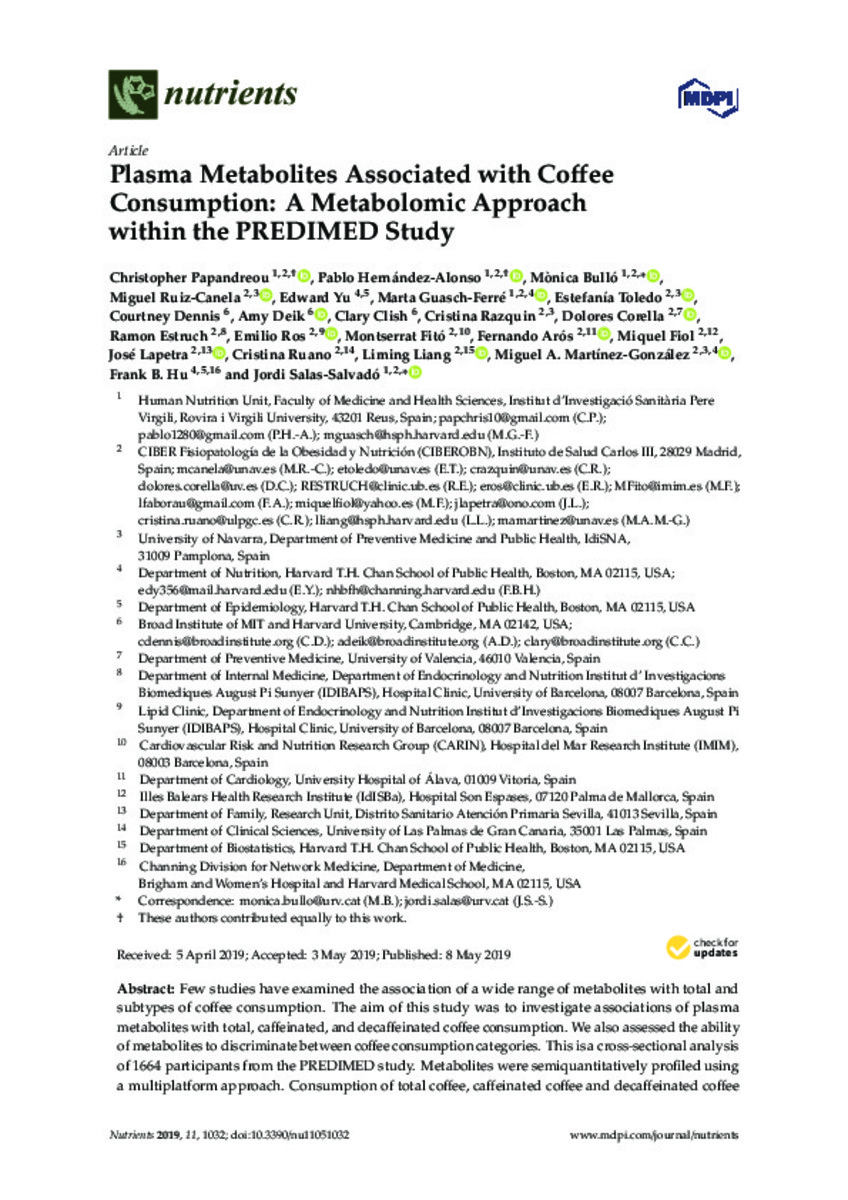Full metadata record
| DC Field | Value | Language |
|---|---|---|
| dc.creator | Papandreou, C. (Christopher) | - |
| dc.creator | Hernandez-Alonso, P. (Pablo) | - |
| dc.creator | Bullo, M. (Monica) | - |
| dc.creator | Ruiz-Canela, M. (Miguel) | - |
| dc.creator | Yu, E. (Edward) | - |
| dc.creator | Guasch-Ferre, M. (Marta) | - |
| dc.creator | Toledo, E. (Estefanía) | - |
| dc.creator | Dennis, C. (Courtney) | - |
| dc.creator | Deik, A. (Amy) | - |
| dc.creator | Clish, C.B. (Clary B.) | - |
| dc.creator | Razquin, C. (Cristina) | - |
| dc.creator | Corella, D. (Dolores) | - |
| dc.creator | Estruch, R. (Ramón) | - |
| dc.creator | Ros, E. (Emilio) | - |
| dc.creator | Fito, M. (Montserrat) | - |
| dc.creator | Aros, F. (Fernando) | - |
| dc.creator | Fiol, M. (Miquel) | - |
| dc.creator | Lapetra, J. (José) | - |
| dc.creator | Ruano, C. (Cristina) | - |
| dc.creator | Liang, L. (Liming) | - |
| dc.creator | Martinez-Gonzalez, M.A. (Miguel Ángel) | - |
| dc.creator | Hu, F.B. (Frank B.) | - |
| dc.creator | Salas-Salvado, J. (Jordi) | - |
| dc.date.accessioned | 2019-06-11T11:13:59Z | - |
| dc.date.available | 2019-06-11T11:13:59Z | - |
| dc.date.issued | 2019 | - |
| dc.identifier.citation | Papandreou, C. (Christopher); Hernandez-Alonso, P. (Pablo); Bullo, M. (Monica); et al. "Plasma Metabolites Associated with Coffee Consumption: A Metabolomic Approach within the PREDIMED Study". Nutrients. 11 (1032), 2019, 1 - 13 | es |
| dc.identifier.issn | 2072-6643 | - |
| dc.identifier.uri | https://hdl.handle.net/10171/57780 | - |
| dc.description.abstract | Few studies have examined the association of a wide range of metabolites with total and subtypes of coffee consumption. The aim of this study was to investigate associations of plasma metabolites with total, caffeinated, and decaffeinated coffee consumption. We also assessed the ability of metabolites to discriminate between coffee consumption categories. This is a cross-sectional analysis of 1664 participants from the PREDIMED study. Metabolites were semiquantitatively profiled using a multiplatform approach. Consumption of total coffee, caffeinated coffee and decaffeinated coffee was assessed by using a validated food frequency questionnaire. We assessed associations between 387 metabolite levels with total, caffeinated, or decaffeinated coffee consumption (≥50 mL coffee/day) using elastic net regression analysis. Ten-fold cross-validation analyses were used to estimate the discriminative accuracy of metabolites for total and subtypes of coffee. We identified different sets of metabolites associated with total coffee, caffeinated and decaffeinated coffee consumption. These metabolites consisted of lipid species (e.g., sphingomyelin, phosphatidylethanolamine, and phosphatidylcholine) or were derived from glycolysis (alpha-glycerophosphate) and polyphenol metabolism (hippurate). Other metabolites included caffeine, 5-acetylamino-6-amino-3-methyluracil, cotinine, kynurenic acid, glycocholate, lactate, and allantoin. The area under the curve (AUC) was 0.60 (95% CI 0.56–0.64), 0.78 (95% CI 0.75–0.81) and 0.52 (95% CI 0.49–0.55), in the multimetabolite model, for total, caffeinated, and decaffeinated coffee consumption, respectively. Our comprehensive metabolic analysis did not result in a new, reliable potential set of metabolites for coffee consumption. | es_ES |
| dc.description.sponsorship | This study was funded by the National Institutes of Health (R01DK102896, F31DK114938, NIH/NHLBI 1R01HL118264, NIH/NHLBI 2R01HL118264), the Spanish Ministry of Health (Instituto de Salud Carlos III, RD 06/0045- Coordinator: MAM-G), the Ministerio de Economía y Competitividad-Fondo Europeo de Desarrollo Regional (Projects CNIC-06/2007, RTIC G03/140, CIBER 06/03, PI06-1326, PI07-0954, PI11/02505, SAF2009-12304 and AGL2010-22319-C03-03), and by the Generalitat Valenciana (ACOMP2010-181, AP111/10, AP-042/11, ACOM2011/145, ACOMP/2012/190, ACOMP/2013/159 and ACOMP/213/165). Dr. Christopher Papandreou was supported by a postdoctoral fellowship granted by the Autonomous Government of Catalonia (PERIS2016-2020 Incorporació de Científics I Tecnòlegs, SLT002/0016/00428). Dr. Marta Guasch-Ferré was supported by EFSD (European Foundation for the Study of Diabetes)/Lilly through the Institut d’Investigacions Sanitàries Pere I Virgili (IISPV). | es_ES |
| dc.language.iso | eng | es_ES |
| dc.publisher | MDPI | es_ES |
| dc.relation | info:eu-repo/grantAgreement/NIH/NATIONAL_INSTITUTE_OF_DIABETES_AND_DIGESTIVE_AND_KIDNEY_DISEASES/1R01DK102896-01/US | - |
| dc.relation | info:eu-repo/grantAgreement/NIH/NATIONAL_HEART,_LUNG,_AND_BLOOD_INSTITUTE/4R01HL118264-04/US | - |
| dc.relation | info:eu-repo/grantAgreement/NIH/NATIONAL_INSTITUTE_OF_DIABETES_AND_DIGESTIVE_AND_KIDNEY_DISEASES/1F31DK114938-01/US | - |
| dc.rights | info:eu-repo/semantics/openAccess | es_ES |
| dc.subject | Coffee | es_ES |
| dc.subject | Caffeine | es_ES |
| dc.subject | Plasma | es_ES |
| dc.subject | Metabolomics | es_ES |
| dc.subject | Predimed | es_ES |
| dc.title | Plasma Metabolites Associated with Coffee Consumption: A Metabolomic Approach within the PREDIMED Study | es_ES |
| dc.type | info:eu-repo/semantics/article | es_ES |
| dc.description.note | This is an open access article distributed under the Creative Commons: Atribution License (cc BY) | es_ES |
| dc.identifier.doi | https://doi.org/10.3390/nu11051032 | es_ES |
| dc.identifier.doi | 10.3390/nu11051032 | - |
Files in This Item:
Statistics and impact
Items in Dadun are protected by copyright, with all rights reserved, unless otherwise indicated.






